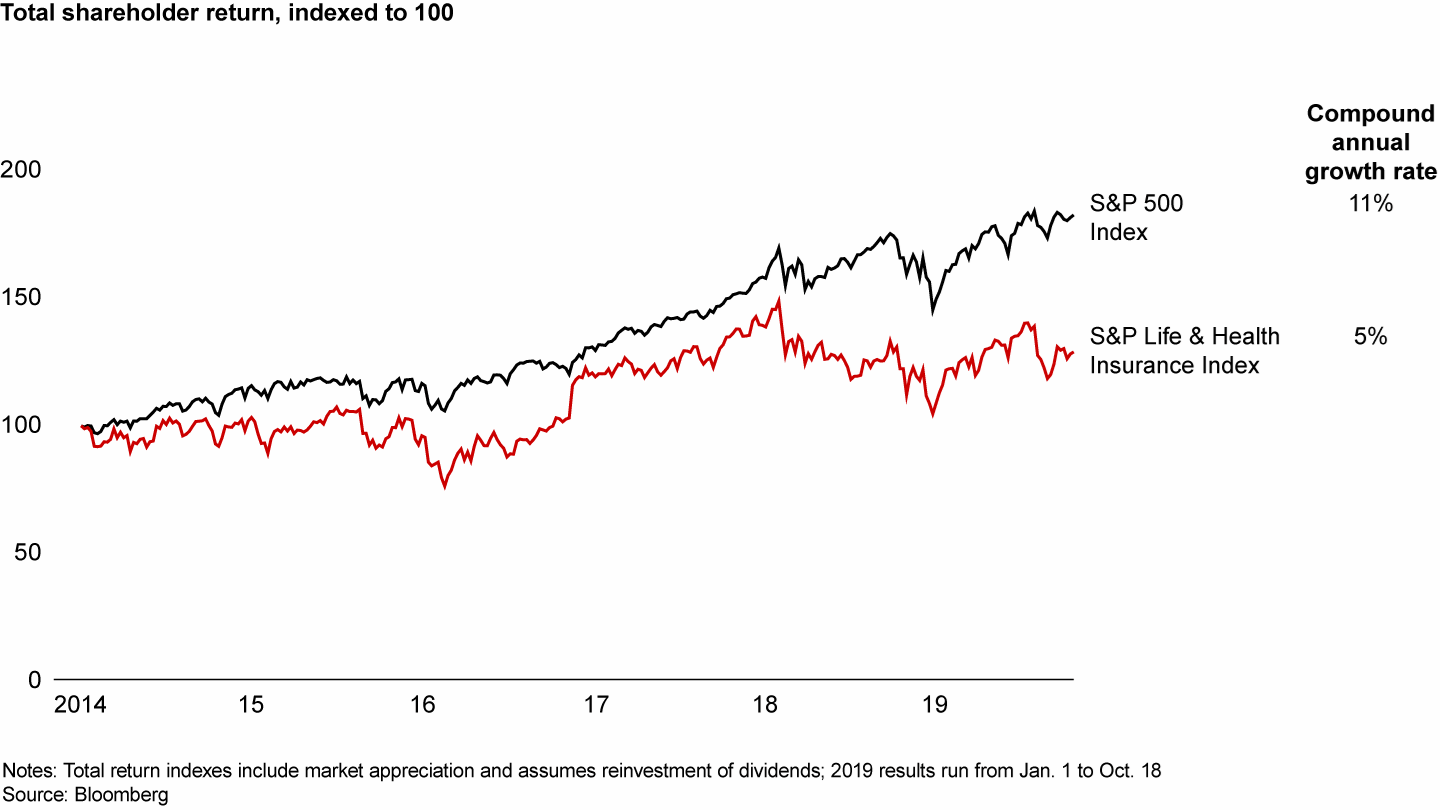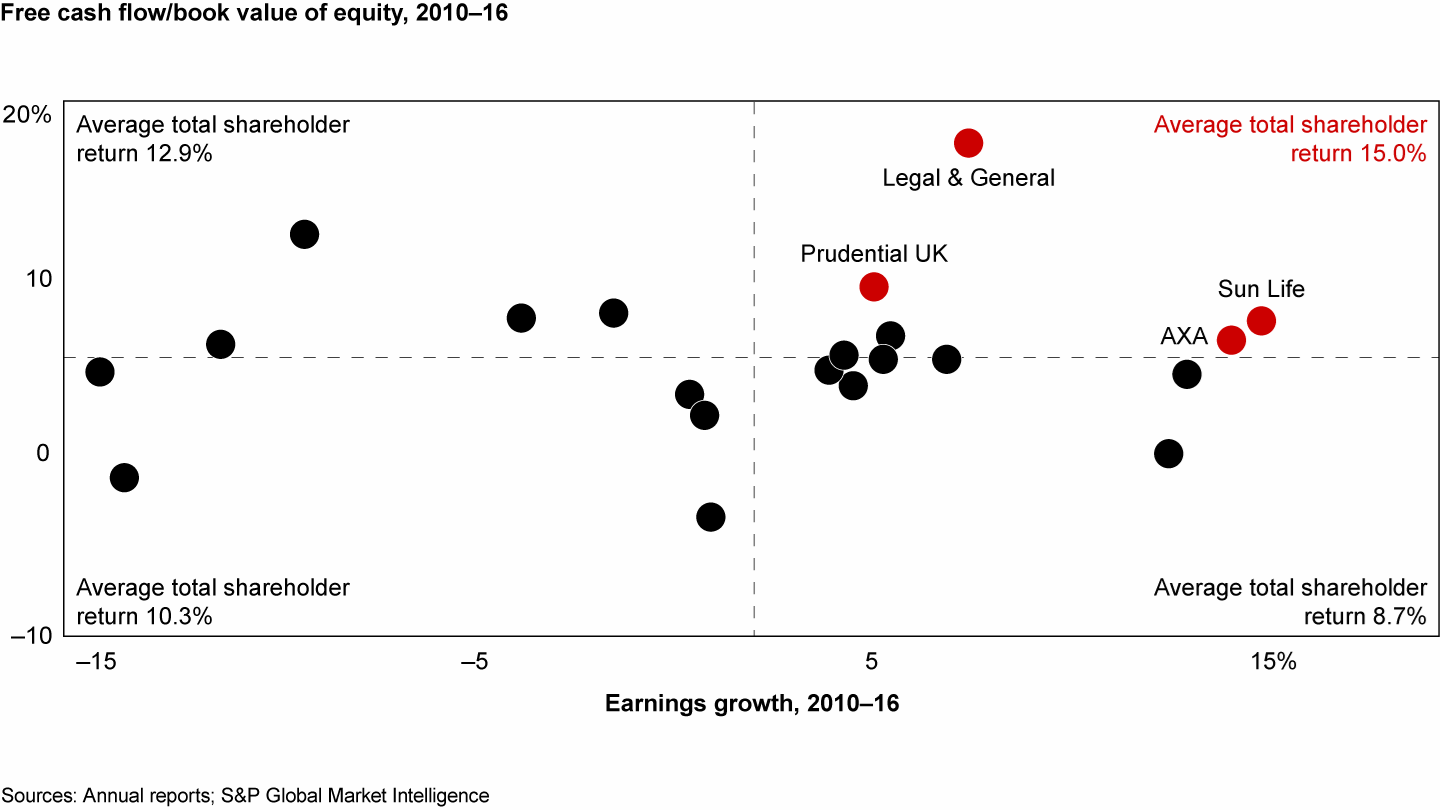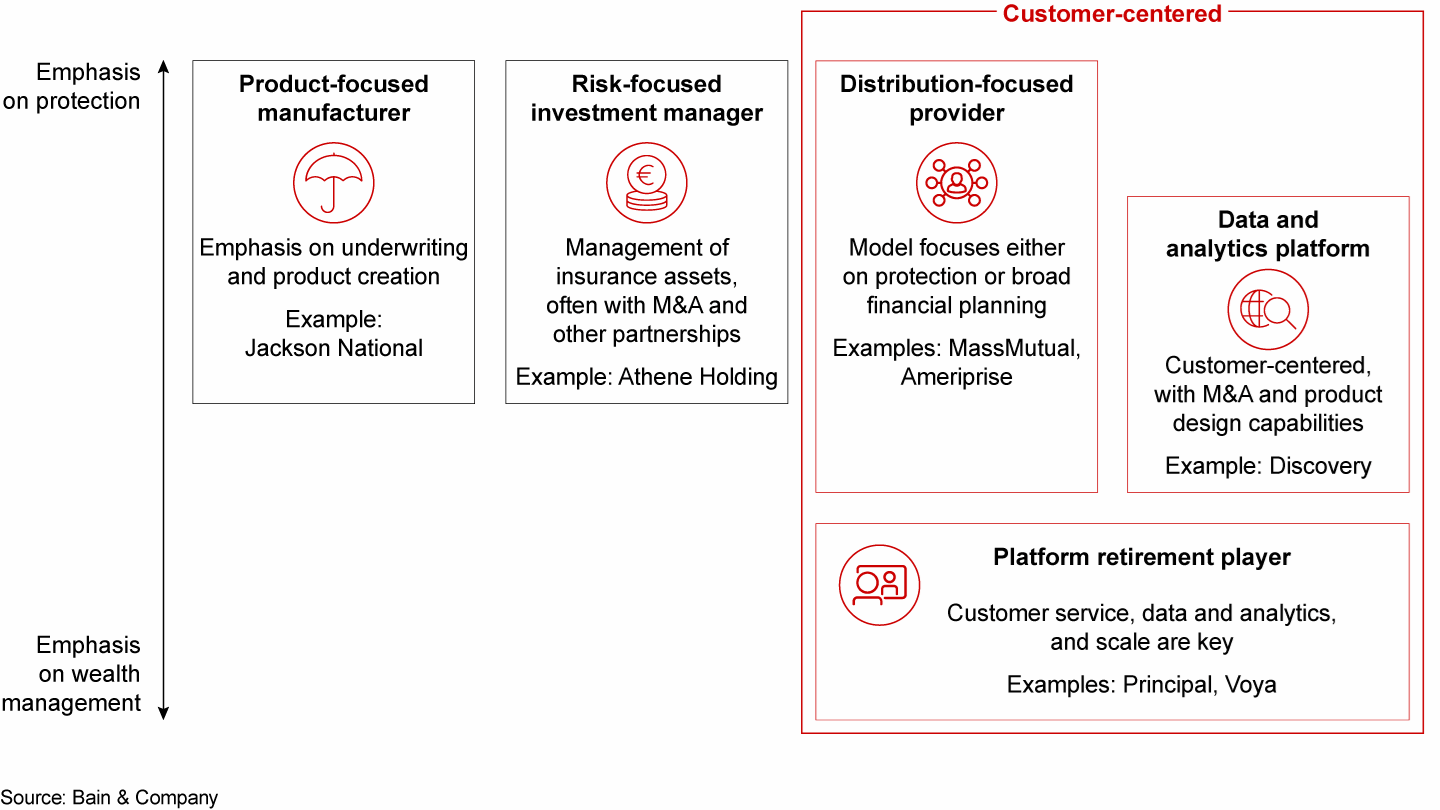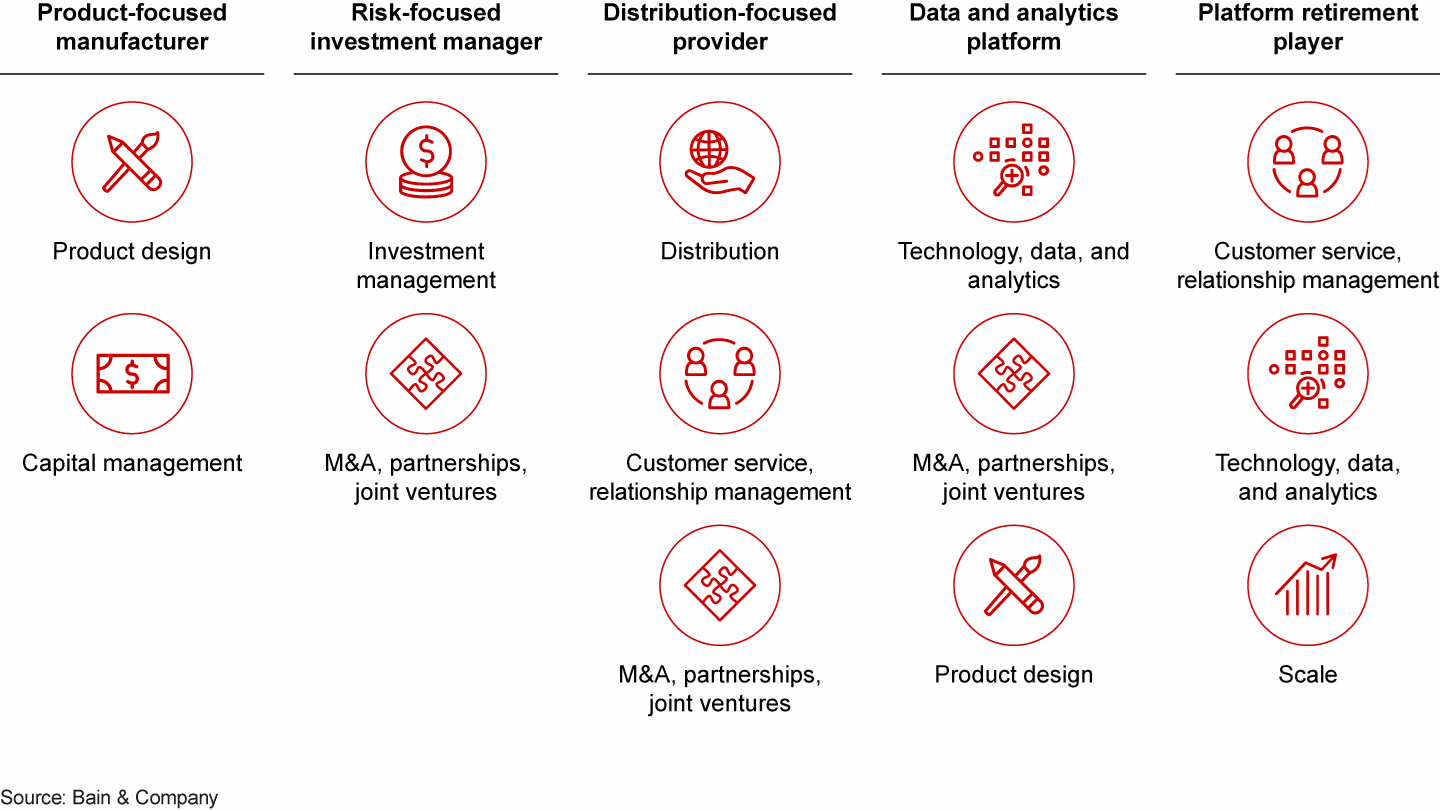Brief

Auf einen Blick
- Returns for life insurance companies have been lagging the overall market, and they face new competition from nontraditional rivals often backed by private capital.
- Moreover, investors are balking at the opaque nature of insurance, demanding clearer explanations for how insurers will generate free cash flow.
- As more insurers look to move into capital-light businesses such as asset management, they face challenges that require different capabilities and business models.
- We see five archetypes as viable for competing in the market, each with a distinctive set of choices and capabilities that must be developed in order to succeed.
Many life insurers are eager to stretch their boundaries, by moving into asset management and other capital-light businesses. They hope to lighten their capital burden, and they see that revenues have been growing faster for asset management than for life insurance, generally with a higher return on equity as well. Investors find it easier to assess earnings projections in asset management, so for a given growth rate, asset managers tend to be rewarded with a higher multiple than from straight life insurers.
But while the grass might seem greener in asset management, that industry comes with its own substantial challenges. Fees have steadily eroded as low-cost passive strategies continue to gain market share at the expense of active strategies. Success in active management is increasingly reliant on innovative alternative strategies. In some countries, investor-protection regulations have cut commission revenues, while stricter compliance requirements have created significant costs for client advisers. Customers’ money has flowed toward mega fund managers geared mainly toward passive strategies, such as Vanguard, or top-performing active funds, which by definition are few and far between.
To create and sustain value in asset management, insurers will have to develop and master some new capabilities. The challenge is less about where to play than about how to win—which capabilities to emphasize through which business model. Moreover, life insurance profit pools (including annuities) remain significant and should benefit from tailwinds such as the growing population of retirees and the opportunity to address people’s ongoing “protection” needs. Success for insurers will likely stem from combining asset management with their unique protection capabilities and providing innovative solutions, for such matters as retirement income and drawing down assets, rather than following a plain-vanilla strategy.
Spurring the existential reflection are major challenges for life insurers in mature markets. Of late, publicly listed insurers subject to quarterly earnings pressures have faced competitors with more visibility into underlying cash flows and returns, as well as with longer-term investment horizons. Private equity and pension fund investors such as Guggenheim, Blackstone and Athene Holding, an annuities investor controlled by Apollo Global Management, have crowded into life insurance. In 2018, some 177 private equity-backed deals closed worldwide, for a total disclosed value of $11 billion. In mature markets, publicly listed life insurers also face competition from mutual companies, due to the mutuals’ access to lower-cost capital.
Lagging the market
The fact is, life insurers globally have lagged in value creation in recent years compared with overall market performance, and often have not covered their cost of capital (see Figure 1). Total shareholder return (TSR) is just one indicator of performance, of course, but few insurers have consistently delivered TSR in the top half of performance for their industry.
Returns for life insurance companies have lagged the overall market in recent years


Since the financial crisis, investors have increasingly balked at the opacity of life insurance financials, because much of what gets booked as earnings is subject to assumptions about interest rates and customers’ longevity. Investors are concerned about some insurers’ legacy exposure to soured businesses such as long-term-care insurance and variable annuities. They also are placing greater emphasis on “intrinsic” measures of value such as free cash flow, dividends and the value of in-force and future business. Investors won’t reward insurers’ earnings growth unless it translates into dividend growth or other cash returns to shareholders. And the best indicator of a company’s ability to deliver dividend growth is free cash flow yield, within a reasonable range, while maintaining a healthy balance sheet (see Figure 2). The low-interest-rate environment will make it even harder to create acceptable levels of distributable cash and returns on capital.
The best-performing life insurers deliver both earnings and cash yield


To deliver value in this environment, insurers will want to make fundamental decisions about their strategy and operations. The first set of decisions involves where to play, including the mix of products; where to participate along the value chain; and which customer segments and countries to target. With those strategic choices made, the next set of choices will determine how to win.
The two industries—risk-based protection and asset management—each comes with distinct challenges. Therefore, insurers must invest in specific capabilities and assets aligned with their strategic and operational decisions. A focus on underwriting and manufacturing requires product innovation and actuarial chops. Alternatively, a distribution-intensive business requires knowing how to use technology to enhance advisers’ productivity in sales and assets under management. To these ends, insurance companies can choose one of the five archetypes that we see standing out in the market, each of which entails clear choices of where to play and how to win (see Figures 3 and 4).
Five archetypes stand out as models for competing in the market


Each archetype for life insurers requires a different mix of capabilities


Product-focused manufacturer
This archetype emphasizes product design and capital management. A good example is Jackson National, which focuses on variable annuities in the US. Jackson’s suite of products offer varying investment options, benefit options and fee structures to address different investor needs, such as annuities targeted to ultra-high-net-worth clients. As the market leader, Jackson also ranks first among variable annuity providers in its Net Promoter Score® (a key metric of loyalty) from advisers. Jackson has a focused product strategy and a clear sense of how to win: adviser-centered distribution with product leadership, backed by the industry’s largest and most productive wholesaling force.
Risk-focused investment manager
Besides the obvious capability of investment management, this archetype tends to succeed through adept M&A, joint ventures and other forms of partnership. A unique partnership with Apollo allows Athene to invest in more specialized, higher-margin securitized assets and eventually move to direct origination.
Distribution-focused provider
Distribution is the key capability, though customer service and relationship management also matter. This archetype comes in two forms, the first being a career agency model focused on protection. For instance, MassMutual leads the US whole life market, but has diversified into a range of protection and advisory products to individuals and employers. In recent years, MassMutual has seen the largest improvement in Net Promoter Score among US life insurers. Customer relationships developed through a captive force of over 8,000 advisers allow MassMutual to excel in cross-selling. And MassMutual continues to innovate, such as with its alternative distribution method through Haven Life, an online direct-to-consumer provider.
The second form focuses on broad financial planning, as exemplified by Ameriprise. The company started as a wealth manager and entered insurance through M&A. It distributes in the US through a nationwide network of high-productivity captive and franchisee advisers. In recent years, Ameriprise has explicitly shifted its focus away from insurance and annuities, growing through a series of well-timed acquisitions in an extended bull market. Operating net revenue per adviser grew 8.5% in 2018, extending a history of continual growth.
Data and analytics platform
Data and analytics capabilities form the backbone of this archetype, supplemented by product design, M&A and partnership skills. Discovery, based in South Africa, is perhaps the most successful example, through its digitally enabled platform called Vitality, a wellness program that rewards policyholders with discounts and perks based on healthy living. Discovery has been building scale globally for Vitality by partnering with incumbents in other countries. Its execution hinges partly on broad cross-selling, where healthy behaviors bring rewards across the product categories. Investors have benefited with an average 16% TSR over the past five years.
Platform retirement player
Both traditional insurers and asset-management-oriented companies compete in this arena. Here a company must master customer service and relationship management, data and analytics, and sustainable scale. Voya, for instance, divested its annuities business and exited life insurance in order to emphasize retirement products for companies of all sizes. Now the company is using its employee-benefits business and focus on financial wellness to expand the platform of services offered in the workplace market. The strategy has reduced Voya’s risk profile and increased free cash flow.
Responding to the challenge of digital disruption
Each archetype poses distinct challenges. For example, some insurers that rely on agent networks become detached from customers’ priorities. Their cultures traditionally emphasized actuarial and distribution capabilities, and the companies invested to keep agents happy. Developing close customer relationships will require new muscles and habits.
Archetypes that depend on strong product design, by contrast, will have to step up their continual innovation by adopting recent technologies such as the Internet of Things, artificial intelligence to optimize risk profiling and price selection, and chatbots for client interactions. John Hancock has shifted to interactive policies that track fitness and health data through wearable devices and smartphones, in partnership with Discovery’s Vitality platform. By creating a program based on preventive health and accrued benefits and rewards, Hancock increases engagement and contact with customers.
Regardless of archetype, insurers must contend with the digital disruption sweeping through their industry, as the number of insurtechs in life insurance has grown rapidly in the past five years. Incumbents have awakened to the need to simplify and digitalize their businesses, to benefit both consumers and advisers. One pioneer of digital technology and analytics is Ping An in China. It started to intensify its focus on digital in 2008 by establishing a dedicated technology arm, and in 2013 launched China’s first all-digital insurer in a joint venture with Alibaba and Tencent. Ping An has become the world’s largest insurer by market capitalization, yet continues to grow rapidly and has delivered a 20% five-year average TSR.
What’s your value creation story?
An insurer also will need to succinctly communicate to investors how it will create value. More investors want to understand a company’s approach to intrinsic value and nontraditional metrics such as free cash flow, not just the traditional metrics of revenue growth, return on investment and dividend growth. This explains why some insurers now incorporate cash metrics into their internal management and external communications. Prudential UK, for example, has made a string of structural changes to grow in a capital-efficient manner, and has spent considerable time educating investors on differing capital flows for new and in-force business.
Many life insurers are at a strategic crossroads, facing new options and decisions about where to invest and grow the portfolio, where to harvest, and which areas to exit. To successfully execute these choices, they must identify which capabilities are critical to develop and master, and which can be “good enough.”
Whatever their choices, insurers must do more than get the business basics right. They also must clearly communicate a compelling story to investors, so that investors understand why and how the business is performing and can gauge the model’s sustainability. Choosing the right metrics to manage and communicate will give investors confidence that an insurer has made the right strategic and operational decisions through and through.
Antonio Rodrigues, Jed Fallis and Andrew Schwedel are partners with Bain & Company’s Financial Services practice. They are based, respectively, in Toronto, Toronto and New York.
Net Promoter Score®, Net Promoter System®, Net Promoter® and NPS® are registered trademarks of Bain & Company, Inc., Fred Reichheld and Satmetrix Systems, Inc.